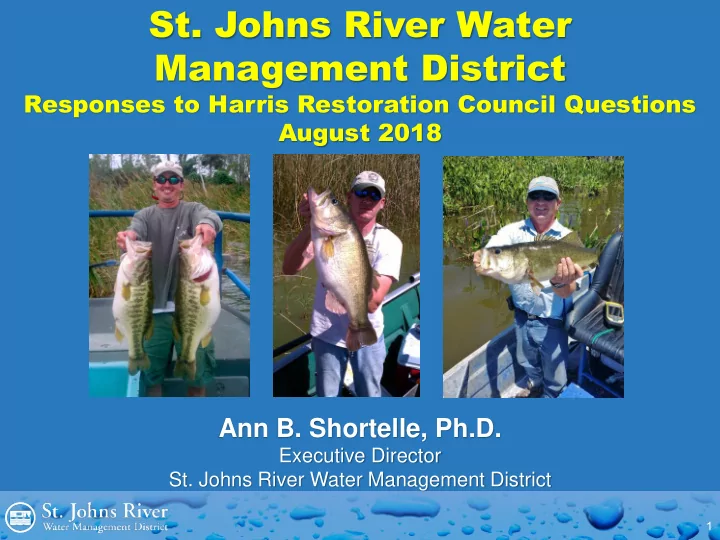

St. Johns River Water Management District Responses to Harris Restoration Council Questions August 2018 Ann B. Shortelle, Ph.D. Executive Director St. Johns River Water Management District 1
Question #1 North Shore Reconnection Council requests SJRWMD and pertinent Council technical advisory group agencies (FWC, FDEP, LCWA) to provide current scientific data in a presentation to the Council that allows the Lake Apopka North Shore(LANS) to either be connected or not connected to Lake Apopka. Council was informed several times during the 2017 Council meetings that the District will not look at reconnecting the LANS until 2021.The Council requests the District analyze or hire a firm to analyze the reconnection prior to 2021. If reconnection is an option, the presentation should include required steps, cost, and timeline. 2
North Shore Reconnection Agree. Managed connections: • Protect lake water quality (P load reduction) • Protect lake fishery • Provide water storage and flood protection 3
Why is 2018 Different than 2017? • Late 2017 pesticide concentrations in fish were below ecological thresholds • The District presented these results to the USFWS in a biological assessment • USFWS concurred with the District’s assessment, allowing the District to begin implementing broader management actions to benefit the lake 4
Why is 2018 Different than 2017? IRMA 5
Why is 2018 Different than 2017? Post-Irma North Shore Levee Repairs 6
Low Lake Water Levels Harm Water Quality and Habitat 7
Flood Protection and Lake Level Augmentation • Discharge capacity through Apopka-Beauclair and Dora canals is limiting during floods • Inlet structures allow District to use LANS for emergency floodwater storage • Use stored water for lake level augmentation, wetland restoration and aquifer recharge 8
LANS Reconnection has Multiple Benefits 9
2018 Question #2 Dr. Mike Allen proved that the harvest of gizzard shad is not effective, in the manner that it is being done, in significantly reducing phosphorus in Lake Apopka. Why is money being wasted on continuing the harvest? 10
Bioturbation and Foodweb Benefits 11
Demonstr Demonstrated ted Success of Success of Shad Har Shad Harvest est • Harvests in 1990, 91, 92 resulted in benefits that persisted for years • No other treatments • No change in watershed or rainfall Godwin et al. 2011. Lake and Reservoir Management, 27(4), 287-297 12
Lake Apopka Gizzard Shad Harvest Cost-Effectiveness Total Fish Catch Total P Cost Effectiveness Fiscal Year Funding (M lbs) (lbs) ($/lb P) 2007 $527,000 1.94 15,540 $34 2008 $530,000 1.57 12,590 $42 2009 $243,000 0.69 5,550 $44 2010 $388,000 0.96 7,660 $51 2011 $279,000 1.00 7,980 $35 2012 $519,000 1.14 9,100 $57 2013 $637,000 1.24 9,940 $64 2014 $637,000 0.90 7,190 $89 2015 $637,000 0.97 7,750 $82 2016 $637,000 0.99 7,880 $81 2017 $637,000 1.06 8,500 $75 Total $5,671,000 12.46 99,680 $57 13
Apopka Shad Harvest 1993 ̶ 2017 Annually • ~1,000,000 lbs fish / year • ~7,000 lb P / year • $57 / lb P over past decade Cumulative > 26.5M lbs of fish removed ~ 217,500 lbs of P 14
Apopka Shad Harvest
Thank You 2018 SAV Monitoring “By-Catch” Present Absent
Recommend
More recommend